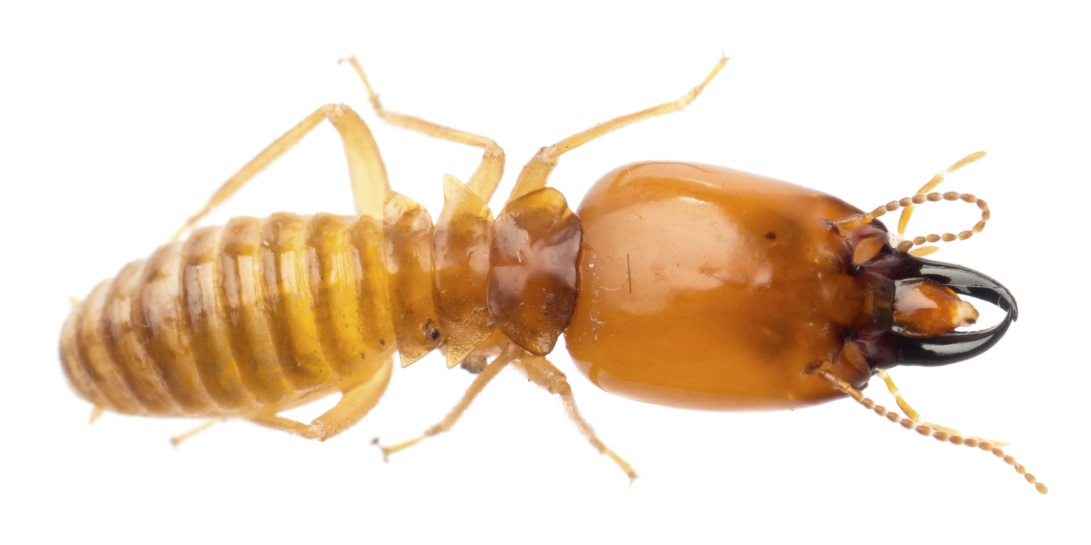
Termite Extermination
Subterranean Termites - Guaranteed Results
Subterranean Termites are well established throughout the Greater Toronto area and they typically damage structural timbers in buildings that are 6 plus years old. Infestations can be reduced by eliminating various construction errors, correcting site grading and proper maintenance combined with a comprehensive inspection of the structure to determine existing activity or conducive conditions.
Termites eat old roots, tree stumps, and branches that have fallen and are considered beneficial when they aid in breaking down this wood. Termites are considered destructive pests when they feed on cellulose materials such as framing, wood fixtures, paper, books and related products associated with a structure.
Termites live in colonies within the ground with three primary castes which are workers, soldiers and reproductive. The workers are creamy white and are often referred to as white ants. The difference between termites and ants are that termites have a thick waist, a straight antennae and the four wings of alate (winged) termites are of equal length and twice as long as the termites body.
During late winter or spring black, winged termites are often seen and are typically a homeowner’s first indication of termites within a structure as the other castes avoid exposure.
The winged termites swarm and are usually attracted to windows and doors (phototropic). The termites wings will break off and they will pair off to mate. They will seek moist wood in contact with soil to begin a new colony. The presence of swarming termites or their wings is a late indicator of termite activity within a structure. The damage causing termites are the seldom seen wingless workers that are protected by the soldiers. The workers and soldiers are intermingled with the workers responsible for the actual damage and the soldiers protecting the entire colony. They are similar in size, white and approximately 6mm with the soldiers distinguishable by their enlarged brownish coloured head and large mandibles (jaws).
Our scientific and hands on termite inspection tests structural timbers above the cellar walls, mudsills, studs, joists, sub-flooring, floors, wooden posts, steps, door frames, and trim embedded in earth or concrete floors as well as wood siding, window frames, and similar material covered by or resting on the ground. We also inspect and test framework within walls and areas around furnaces, chimneys, hot water heaters and hot water pipes.
We use infrared thermography with a certified Level one infrared thermographer, ultrasound, moisture metres, borescopes, density detectors, compressed air, ultraviolet light, Kestrel thermometer and CO2 and methane detectors to inspect, test and validate suspicious areas for activity including under stucco and veneer at grade and even below grade.
Our goal is to know the structure completely and to advise correction of conducive conditions and to discover activity when spot target treatments are still an effective treatment option. More comprehensive barrier treatments and structural chemical applications are a last resort used only when infestations are well established within a structure. All treatments are completed in conjunction with appropriate recommendations to eliminate additional hot spots for termite activity.
For more information on dealing with your termite infestation, or for a no-obligation termite extermination estimate, please call us at 1-800-743-4623, or use our contact form.
Termite Inspections - Guaranteed Results
Gold Standard non-destructive termite inspections for homes and business in and around the Greater Toronto areas.
Critical to the success of termite elimination is detection, which includes the inspection activities to determine termite hot spots and the extent of termite activity within a structure.
A thorough inspection including validation begins with an Infrared structural analysis to narrow down areas requiring special attention. Infrared Thermography by a certified Level one Infrared Thermographer provides the most comprehensive understanding of an entire structure from a termite and moisture perspective. It discloses evidence to ascertain the location, type and conditions associated with termites. The Infrared camera provides our highly skilled certified operator with anomalous differentials in heating and cooling thermal signatures. This deeper inspection provides more accurate data including determination of damage extensiveness and damage clarification simply by creating a diagnostic delta.
The subtle thermal imagery variations indicate termite related anomalies associated with termites. Skilled interpretation and analysis of the data combined with validation techniques allow us to find both: a) areas exhibiting anomalous elements that could be associated with the presence of latent moisture or hot spots and b) the presence of subsurface defects that are indicative of a current or former termite problem.
The investigation is complemented with additional termite detection tools to validate the anomalies detected by the tonal contrasts discovered with infrared thermography which provides a definitive diagnosis. Moisture meters, microwave detection equipment, acoustic emissions detection equipment, CO2 and methane gas detectors, structural test equipment and borescopes are used after the preliminary thermography finding as the entire solution truly begins with detection.
Our standard termite inspection process steps are:
- Preliminary finding
- Validation
- Confirmation
- Suspicion
- Validation of Suspicion
- Result
- Validation
- Result
- Search
- Diagnosis
Our accurate, scientific termite activity determination permits the strategic placement of chemicals in to hidden pest activity areas. This targeted chemical placement ensures effective resolution and our post treatment follow-up inspection confirms that the two factors that constitute a successful termite extermination program are addressed, namely:
- The removal of contributing factors such as moisture and the thermal imager can confirm this correction
- Confirmation of remedial actions effectiveness
We are fully committed to the principles of Integrated Pest Management and Integrated Pest Thermography in our mission to correct or prevent termite and other pest infestations in the least amount of time possible, with minimal environmental impact.
For more information on termite inspections, or for a no-obligation extermination estimate, please call us at 1-800-743-4623, or use our contact form.